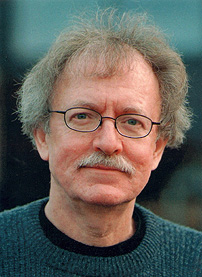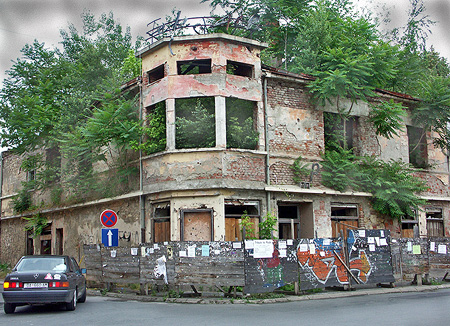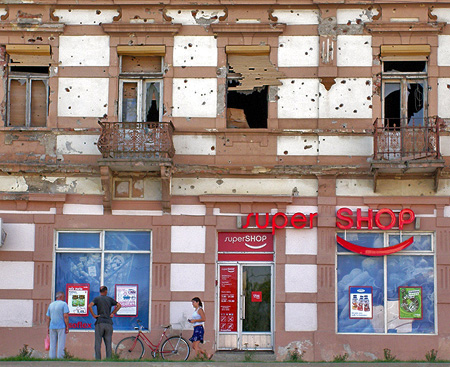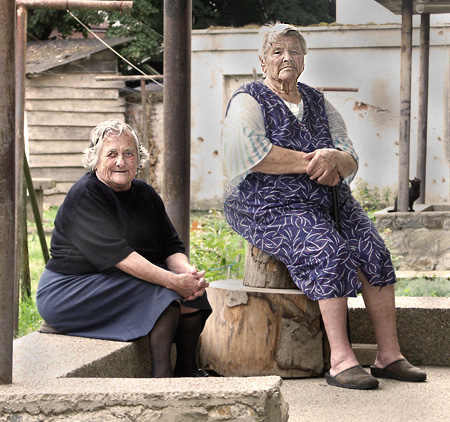Revisiting Pakrac
in Croatia -
where the war started in 1991

By
Sören
Sommelius
February 9, 2007
BEFORE THE WAR, THE HIGHWAY ”BROTHERHOOD AND UNITY”
through Yugoslavia was the artery from Central Europe to the Balkans.
Now there is no Yugoslavia; and there is neither brotherhood nor unity,
the motto of Titoism. The highway – Autoput - carries little traffic
when I pass by Zagreb on my way eastwards.
A few miles after I’ve left the autoput, the still war-scarred landscape
emerges.
Marina Maic, 26, and her sister Valentina, 18, are waiting for me in Café
Scorpion in Pakrac in Western Slavonia. Scorpion was an oasis during the
war, named after a paramilitary group. I recognize its owner Djuro, who
proudly points at his unit on a big photo on the wall.
Marina is a mother of two children, studies law at the university of Zagreb
and wants to become a judge. Valentina dreams of becoming a tourist guide
on the coast of Croatia.
Marina has to study intensely for an examination the following day. She
must take the morning train at five to the capital. Valentina accompanies
me on a walking tour through Pakrac’s centre and serves as interpreter.
*
IT’S THE FOURTH TIME I am here. I was here twice
during the war in the early 1990s. I am curious to know what has happened.
Will I see signs that the wounds of war have healed?
The answer comes to me quickly, No, hardly. The time has stood still here.
In the very last days of 2006, or fifteen years after the terrifying warfare,
Pakrac is still a badly mangled town. Many buildings in the centre are
still mere ruins, most of their fronts are perforated by the frightening
graffiti of bullet holes.
We take a walk along the modest main street Ulica Gojka Suska. Some houses
have been renovated. A little Chinese shop with cheap goods is something
new. Gojko Susak was a tough nationalist extremist and a Croatian-Canadian
pizza millionaire (he owned a pizzeria chain) who mobilized capital among
the North American Croats for the liberation struggle and later became
minister of defence himself. Now the main street of Pakrac is named after
this man who ought to have been indicted as a war criminal.
Thus one version of history manifests itself in the names of streets and
market squares. Neither the many years that have passed nor the human
suffering and destruction has given way to the tiniest idea of reconciliation.
*
A DEPARTMENT STORE with a tower stood on a street corner.
I took a picture of the ruin in 1993. It still stands thirteen years later
exactly as it was, however with one difference: a whole grove has grown
up inside the ruin. It looks like an installation of modern art representing
the folly of war, a botanic park in a bombed-out store.

Pakrac,
Croatia © Sören Sommelius 2007
The Susak Street leads to a bridge over the little
Pakra river, beyond which there is a beautiful old three-storeys building,
Hotel Pakrac. But here are no rooms for vistors. The building is a crumbling
ruin, most of it a bombed out shell of walls decorated with bullet holes.
It is painfully beautiful and gruesome at one and the same time.
– For me the hotel was only an exciting and dangerous playground.
It took a long time before I understood what the building had been before,
says Valentina. She was three when the war started.
The door of what had once been a hotel kitchen has long ago been smashed.
Inside I sense the smell not of food but of excrement.THE NEXT DAY, MARINA
FEELS GOOD. The exam went well. We slip into Pizzeria Tessari, one of
the few functioning eateries in town. Marina recalls how the war started.
– I was taking a biking ride when I suddenly saw road blocks and
a lot of soldiers. I returned home as fast as I could. My mother took
us children to the hospital where she was working. There we stayed for
a month in a room in the basement with some 14 or 15 other children.
Marina’s mother phoned relatives to find a place to take refuge
in.
– We got away on a bus heading for Zagreb. At one point, the road
was blocked by mines, but somehow we got there and could then move further
on to a place at the sea. We stayed there for a year.
*
THE FIRST SHOTS of the Yugoslav dissolution wars were
fires in Pakrac on the 2nd of March 1991. The worst battles in Croatia
were to take place further eastwards around Vukovar. But the war started
in Pakrac and the region of western Slavonia that dreary March day.
World War I, it is often stated, began with the shots in Sarajevo in June
1914. Is Pakrac of the 1990s the Sarajevo of the Yugoslav wars of disintegration?
Well, perhaps in a way. But Pakrac in 1991 witnessed none of the revolutionary
actions or spectacular murders of imperial heirs as did Sarajevo in 1914.
Pakrac was about more mundane things in life; indeed, the concrete triggering
factor was utterly trivial: the control of the municipal police station.
From a different but probably more relevant perspective, the war was about
fear – fear of history coming back, fear for the other side be it
Croat or Serb and fear for the future.
What actually happened? There are different versions, different chains
of events, different perspectives. But they have one thing in common –
each side places the guilt on ”the others”.
Many people who would be able to tell no longer live in Pakrac. Ten years
after the outbreak of the war, 12.000 inhabitants had fled to other countries
or other parts of Croatia. Only few of them have returned.
So we make an appointment with the Chief of the police in Pakrac to get
his version. But when we arrive at the station at the agreed time he has
left for “urgent matters.”
Marina who has arranged the interview sighs.
– But he is only a little above thirty today. How would he be able
to describe what happened?
What a strange war! No one knows why it started.
If you want to build roads to peace, would you not try to understand and
identify the roads that led to war?
*
THE POLICE STATION OF PAKRAC is situated near what has
now been named the Square of the 76th Battalion, close to the Municipal
Hall. This is where the UN office was during the war. When I visited Pakrac
in January 1993, this hall was guarded by four white UN armoured vehicles,
while inside an exchange of prisoners was being discussed.
The ”front” used to be exactly here. This was the checkpoint
between the Croatian and Serbian sides. Pakrac was a divided town and
a symbol of the new age, as Berlin was a symbol of the Cold War. In UN
terminology the area was called “Sector West”. The southern
”Serbian” side belonged from 1991 to 1995 to the short-lived,
self-declared seceding Serb state, Republika Srpska Kraijna (RSK), that
mainly consisted of areas with a Serb majority.
TODAY there are no traces of the checkpoint. Where the border bar was
there is now a stop sign for cars coming from the Granica quarter (earlier
in Republika Srpska Kraijna) before they can enter the Square of the 76th
battalion. The traffic is sparse, people are few and there are ruins on
both sides of the road.
I remember the questioning and the checking here, unpleasant and arbitrary.
Many of the soldiers had an air alcohol around them and displayed aggressive
feelings and manners.
For a long while I stand where the checkpoint was with my Minolta camera
and try to remember how it was.
A few weeks suffice to plunder and destroy a town. But it takes decades
to repair, renovate, reconstruct and, perhaps even longer, to reconcile.
When there is no money, the physical scars of the war remain in the landscape
as festering wounds. When this is what the physical environment displays
so many years later, I wonder anxiously what I would find if I could only
look into the hearts and minds of those who are still here and those who
have either not be able or willing to return?
To build roads to peace we’ve got to trace and understand the path
that led to war and create structures that are conducive to reconciliation.
I see none of it here.
The war changed Pakrac from a Yugoslav to a Croatian town, from a prosperous
multicultural little town to a poor, mostly mono-cultural place where
most people lack jobs and money, and probably hope too.

Lipik,
Croatia © Sören Sommelius 2007
*
AT DAWN ON THE 1st OF MAY 1995, 7200 Croatian soldiers
passed the checkpoint and took control of the Serb-held parts of Western
Slavonia. Operation Lightening lasted for 31 hours. It was followed by
the bigger Operation Storm in August the same year, lasting a week, which
brought back the region around Knin to Croatia and created gigantic refugee
columns after a merciless ethnic cleansing. This operation also forces
the United Nations, the world organization, out of these regions –
which bothered few in the media and elsewhere.
The superiority of the Croatian Army can be explained not least by the
fact that it had been trained by retired American officers from a corporation
called ”Military Professional Resources Inc” (MPRI).
IN AN OLD PEOPLE’S HOME in Pakrac lies Martina’s grandfather
Djuro, soon 80 years old. He can neither walk nor sit after his second
stroke. The war made him drink too much and the alcohol led to stroke.
He has lost everything.
- He has become quite sentimental, Martina says before our visit. He starts
crying for nothing. Be prepared for that. There is nothing wrong with
his head, but his body doesn’t obey him any longer.
Djuro has lived his life as a Yugoslav in Batinjani, a village outside
Pakrac. He was born there, went to village school there and worked for
forty years in the furniture factory of Pakrac, while his own house with
its garden was a fertile ground from which the household thrived.
– We had all we needed. The job was good and all that was produced
could be sold. It certainly isn’t like that anymore. Now his house
stands abandoned beside a completely destroyed Serbian house. Djuro says:
– My neighbour and I grew up together and went to the same class.
We were very good friends. His house was destroyed, but every day for
many years I looked after his garden and hoped that he would return. But
he didn’t. He now lives in an old people’s home in Serbia.
And here I am lying. We have no contact.
When he thinks of his friend he starts crying and covers his face with
his hands.
*
PAKRAC IS AN UNIMPORTANT east Croatian town in the province
of Slavonia. In the municipality lived 27.000 people before the war in
1991, 48 per cent of them Serbs and 36 per cent Croats. The history of
the town goes back to the 14th century, when Slavonia belonged to Hungary.
In the 16th century the Turkish-Ottoman Empire expanded northwards and
for two centuries Pakrac was governed from Constantinople. At the beginning
of the 18th century it was incorporated into Habsburg Austria.
There are no remains from Ottoman times. The town mostly
looks like a battered Austrian town. After World War I, this Austrian
town became Yugoslav, with an ethnically very mixed population.
During the World War II, Pakrac belonged to the fascist Ustasha controlled
Croatia, a Nazi satellite state of Hitler’s Germany. The annihilation
camp of Jasenovac is located only some ten miles away.
After the Second World War, in Tito’s Yugoslavia, people looked
more forwards than backwards. Memories of wartime cruelties began to wane.
The percentage of ”mixed” marriages increased and was perhaps
the greatest in all of Yugoslavia. This was a fertile agricultural region,
with some medium-size industries. Prosperity spread. That is, until that
war broke out on that March day in 1991 and sparked the dissolution of
the rest.
THE JEWS OF PAKRAC vanished in the Second World War. Many were executed
at Jasenovac, at the Sava river, which today forms the border between
Croatia and Bosnia.
Jasenovac has been described as a Yugoslav Auschwitz, a tool of Ustasha.
The camp became a national memorial in Tito’s Yugoslavia. There
is a museum and, outside it in the plain landscape, a gigantic bombastic
flower in concrete.
The answer to the question: How many were murdered at Jasenovac? - remains
controversial. But hundreds of thousands were brutally murdered here,
mainly Serbs, Jews, Gypsies/Romas, and communists. Independent Croatia’s
first president Franjo Tudjman played down the figures.
I visited that former museum a few times in the 1990s. It had then been
successively vandalized and desecrated. Still here right before new year
2007, Jasenovac had not been reopened in the village of the storks.
Smrka Jelka is not a museum chief, rather a kind of curator of the future
museum.
– We are working on a permanent exhibition, which I hope will be
ready this year, she says.
Mrs Jelka relates how Jasenovac like the German concentration camps had
several sub-camps of different size. In the main camp there was originally
a brick factory, which in March 1942 was remade into a crematorium. In
the district there are 125 mass graves on nine grave fields. There may
actually be more. In the summer of 1942 the first children’s camp
in Europe was established here.
Are there connections to Pakrac? - I wonder.
– During 1942 the prison of Pakrac, near the cattle market, was
used as a collection point for children and women (Serbs, Jews, Romas,
communists) who waited there before being sent out as unpaid slave workers
to Croatian peasants.

Women
in Pakrac, Croatia © Sören Sommelius 2007
IN THE TWIN TOWNS of Pakrac and Lipik there are a few
factories where production has started after 2000, specially the glass
factory Staklana and the mineral water factory Studena, both half-owned
by Italians.
Studena is a modern factory. Its ”mineral water is sold all over
the country in professionally designed plastic bottles.
Staklana makes car windscreens for, among others, Bentley and Ferrari.
It is an irony of fate - or rather a consequence of the globalised division
of labour - that here in the war-damaged Pakrac windows for luxury cars
are produced, while many houses still lack panes of glass in their windows.
The factory’s turnover is about US $ 4 million a year. Marina’s
husband works there as an electrical engineer.
*
MARINA’S FATHER ZDRAVKO MAIC joined
the Croatian Army when the war started and became commander of a force
of 500 men in Pakrac. Zdravko participated in both of the two cleansing
operations of the Croatian army in 1995.
Were you there when the Croatian Army destroyed Serbian houses?
– I took part in everything that happened in those years. But I
don’t like talking about it. When I see all damaged or destroyed
houses the memories come back.
He visits a psychologist once a week, like so many others. PTS, he says
and gets earnest. So he has done for nearly ten years.
– Eight years ago I got a severe depression. I was hospitalized
for more than four months.
Posttraumatical stress. Before the war Zdravko served as fire inspector
in the furniture factory.
– Why was there a war?
– It is difficult to understand, he replies. We were all like one
big family. There were jobs and money.
- Is life today influenced by the war?
– Yes, very much. Before the war I was in the prime of life and
believed in the future. During the war I took part in so many difficult
things that turn back in my memory.
Zdravko meets friends in the Club of Disabled Persons in Ulica Susak almost
every day.
His son, Marina’s and Valentina’s younger brother, works in
the new elegant supermarket on the outskirts of Pakrac. Quite recently
he came home and told us that he had fallen in love.
– He has met a Serbian girl and that makes me happy. Slowly the
wounds are healing. One day it will be normal in Pakrac. But it will take
even more time.
Copyright
© TFF & the author 1997 till today. All rights reserved.
Tell a friend about this TFF
article
Send to:
From:
Message and your name
Get
free TFF articles & updates
|